
A Guide to Steam Tables
Steam tables make it easy to serve a spread of hot food to a large crowd while maintaining food-safe temperatures. They're commonly used in buffet setups and catering events to present a wide selection of dishes for self-service. They help in organizing food displays, maintaining temperature consistency, and ensuring a smooth flow of service for large gatherings. We'll outline the different features of steam tables to help you choose the configuration that meets your needs.
Shop All Commercial Steam Tables
What Is a Steam Table?
A steam table is a type of food-holding equipment designed to keep hot foods at a safe holding temperature in high-volume businesses. They're ideal for use in kitchens, buffets, cafeterias, or hotels. They typically feature two or more compartments to hold full-size pans or a combination of smaller pans. With multiple compartments and adjustable heat controls, steam tables allow for the simultaneous holding of various dishes at different temperatures. This makes it easier for foodservice operators to manage a diverse menu and serve hot dishes promptly.
Keep in mind that steam tables are designed to hold pre-cooked foods that are already heated. Food cannot be cooked in a steam table and cold food cannot be reheated.
How Do Steam Tables Work?
To keep food warm, steam tables heat water to produce steam that gently heats the food pans. This method provides even heating to ensure all of the food pans are kept at the ideal temperature. Both sealed and open-well steam tables can utilize moist heating, which involves using water to create steam to heat the pans from underneath. Only open-well steam tables can use dry heating, which is the process of heating the pans without water.
How Hot Must Food Be Kept in a Steam Table?
To meet food safety guidelines, hot food should always be held at 135 degrees Fahrenheit or higher.
Types of Steam Tables
One of the key decisions you'll need to make when purchasing a steam table is whether to opt for a gas or electric model. Both options are suitable for commercial use and can help streamline your foodservice operation by keeping dishes hot and ready to serve. Ultimately, the choice between gas and electric steam tables will depend on your specific needs and budget constraints.
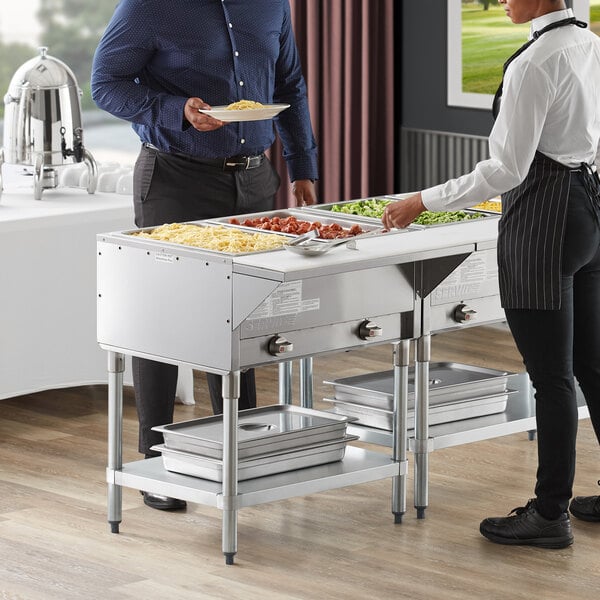
Gas Steam Table
Gas steam tables are designed to be configured for either natural gas hookups or liquid propane tanks. Gas steam tables are quicker to heat up with less possibility of malfunction due to their simpler design. The cost of gas is typically cheaper than electricity but it is not as energy efficient and will raise the temperature of the kitchen or dining area in which it is being used. Most gas steam tables are designed to be stationary, but casters can be mounted onto propane-powered units for outdoor applications like catering events.
- Gas is a more affordable utility than electric
- Gas steam tables heat up quickly
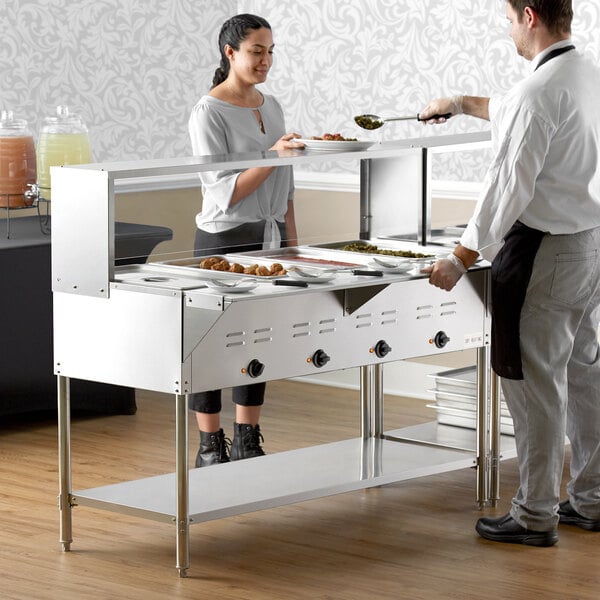
Electric Steam Table
Electric steam tables take a little longer to heat up, but they are more energy efficient. They won't heat your kitchen, and they include easy-to-use, more precise temperature controls. Some electric tables use NEMA plugs while others must be hardwired (configurations available during the purchasing process). If you need to be able to easily move your table, then a portable steam table may be a better option for your business. Mobile electric steam tables with casters are ideal for applications like breakfast bars, where you might need to put your table into storage after use and then easily take it out again the next morning.
- Can be installed anywhere with electrical access
- Energy efficient
Steam Table Wells
There are two kinds of well types for steam tables: open and sealed. These refer to whether the heating element of an electric unit or the open flame of a gas unit is covered or exposed. Open wells feature an exposed heat source, and because of this, spillage pans are needed for open well moist heating. Conversely, sealed wells have a covered heat source. The heating element or flame rests underneath the metal well, allowing you to add the water directly without needing spillage pans.
Open-Well Steam Table

Open-well steam table units are versatile because they can utilize both moist and dry heating at the same time. Dry heat is especially good for holding fried foods and other crispy menu items. Open-wells feature an exposed heat source and require spillage pans for open well moist heating.
- Can be used for moist or dry heat holding
- Can be more cost-effective upfront
- Requires the use of spillage pans, which must be emptied after service
Sealed-Well Steam Table

Sealed-well steam tables are deisgned with a covered heat source. The heating element or flame rests underneath the metal well, allowing you to add water directly to the unit without needing spillage pans. If your menu consists of soups, rice, veggies, pasta dishes, and other non-crispy options, a sealed-well steam table may be the right choice for you.
- Features a built-in drain for easy cleanup
- Water is added directly to the well (no spillage pans required)
- Cannot be used for dry heat holding
Steam Table Features
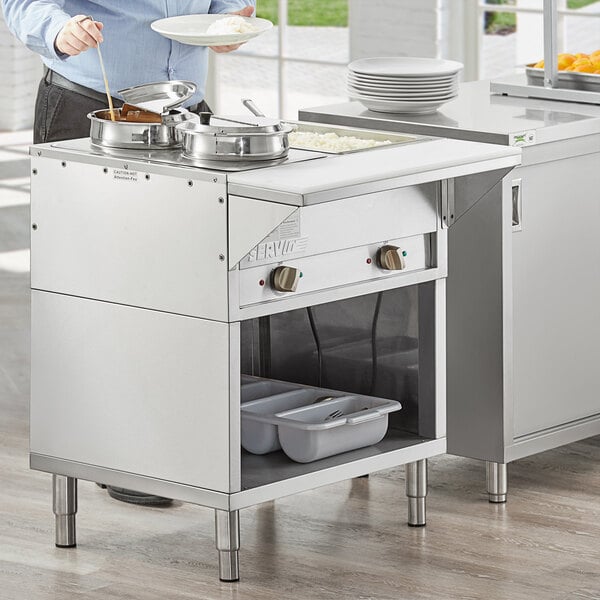
When selecting a steam table for your restaurant, there are features and configurations to keep in mind:
- Number of Wells: Steam tables come in configurations ranging from one well to multiple wells, depending on the volume of food you need to keep warm and the variety of dishes you want to offer. Single-well steam tables are ideal for smaller operations or for serving a limited selection of dishes. These units are compact and easy to move, making them a good choice for catering events or food trucks where space is limited. For larger establishments or those serving a wide range of menu items, multiple-well steam tables are a better option.
- Mobile or Stationary: Mobile steam tables are designed with casters or wheels, allowing for easy mobility around your kitchen or catering event space. This feature is ideal for businesses that require flexibility in their setup or frequently need to move the steam table from one location to another. On the other hand, stationary steam tables are fixed in place and do not have wheels for mobility. These models are typically larger and offer more capacity compared to mobile steam tables. Stationary steam tables are best suited for businesses with a dedicated serving area or buffet line where the table will remain in one location.
- Infinite Controls or Thermostatic: With infinite controls, you can set the heat output to one of two preset levels: high or low. This allows for easy operation and quick adjustments, making it ideal for busy kitchens where speed and efficiency are essential. Thermostatic controls offer more precise temperature control. These controls allow you to set a specific temperature, which the unit will then maintain by cycling on and off as needed. Thermostatic controls are ideal for situations where precise temperature regulation is crucial, such as when holding delicate food items that require consistent heat levels.
- Indoor or Outdoor Use: Indoor steam tables are designed for use in commercial kitchens or buffet setups within indoor environments. outdoor steam tables are specifically built to withstand the elements and temperature variations associated with outdoor use. They are constructed with weather-resistant materials and are often equipped with additional insulation to maintain consistent food temperatures in outdoor settings. Outdoor steam tables are commonly used in catering events, food trucks, or outdoor dining areas where food is served outside.

Steam Table Accessories
When setting up a steam table in your commercial kitchen, it’s essential to equip it with the right accessories to maximize its functionality and efficiency. Steam table pans and adaptors are crucial components that enhance the performance of your steam table and help you serve hot and delicious food to your customers.
- Steam Table Pans: These food pans are made of stainless and come in a variety of sizes, from 1/9 pans to 2/3 pans.
- Adapter Plates: Use adapter plates to create custom configurations for your steam table presentation.
- Adapter Bars: Reduce the steam loss with adapter bars to increase efficiency and change the configuration of your table with fractional pans.
- Shelves: Install overshelves to provide extra storage space above your table. Some come with sneeze guards to bring added protection to your steam table unit.
- Cutting Boards: Add a cutting board to your unit to provide additional workspace for food prep and plating.
- Water Filtration System: Ensure that the water you are using in your steam table is clean and sanitary with a water filtration system.
- Spillage Pans: Use open well moist heating with a steam table spillage pan. Fill your spillage pan with hot water and place your food pan on top.
Related Resources
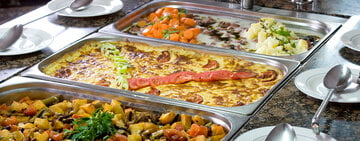
Types of Food Wells
Buffets and self-service lines are practical methods for delivering large quantities of food to numerous people over an extended period of time, and every setup needs an assortment of food wells to function effectively. Food wells are available in multiple sizes, shapes, and styles to suit different circumstances, but the general idea is to provide open food storage while keeping product at safe temperatures.
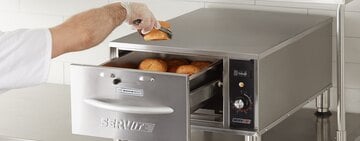
A Guide to Commercial Drawer Warmers
Commercial drawer warmers are essential equipment for foodservice establishments looking to maintain the quality and temperature of their prepared dishes. These versatile units are commonly used in restaurants, catering businesses, cafeterias, and other commercial kitchens to keep food items warm and ready for serving. Understanding the different types of drawer warmers and how to properly operate and care for your unit allows your restaurant to serve warm and fresh meals to customers, enhancing their overall experience. Shop All Warming Drawers Use the following links to explore the different features of warming drawers: What Is a Drawer Warmer? What Are Drawer Warmers Used For? Benefits of Drawer Warmers Types of Drawer Warmers Drawer War
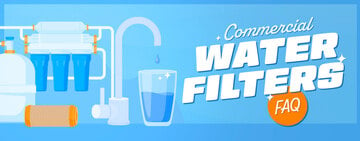
Commercial Water Filters FAQ
As a restaurant owner, ensuring the quality of your food and beverages is crucial for the success of your business. One key component that often gets overlooked but plays a significant role in maintaining that quality is the water filter system. Water filters are essential for providing clean and safe water for cooking, drinking, and ice production in your restaurant. Filtering your water also helps prevent mineral buildup and sediment accumulation in your equipment, such as coffee makers, ice machines, and steamers. This buildup can lead to clogs, corrosion, and reduced performance, ultimately affecting the lifespan of your equipment. If you have questions about water filters and their importance, we created this FAQ for you. Shop All Wate
- Topics 1359
- Industrial 55
- Troubleshooting Guides 21
- Restaurant Management 128
- Bar Management 56
- Catering Tips 37
- Bakery Management 42
- Food Trucks & Concessions 49
- Advertising & Marketing 37
- Eco-Friendly Tips 11
- Facility Layout & Design 42
- Coffee Shop Tips 28
- Installation & Maintenance 51
- Janitorial & Pest Control 30
- Safety & Sanitation 88
- Startup Tips 104
- Menu Design 10
- Kitchen & Cooking Tips 84
- Hospitality Management 24
- Pizza & Sandwich Shop Tips 36
- Smallwares 37
- Food Prep 89
- Tabletop Items 17
- Disposables 22
- Calculators & Tools 6
- Consumables 52
- Warewashing & Laundry 19
- Cooking Equipment 92
- Food Storage & Refrigeration 51
- Beverage Equipment 35
- Office Supplies 6
- Resource Type
- In-Depth Articles274
- Buying Guides299
- How-Tos95
- Product Reviews78


